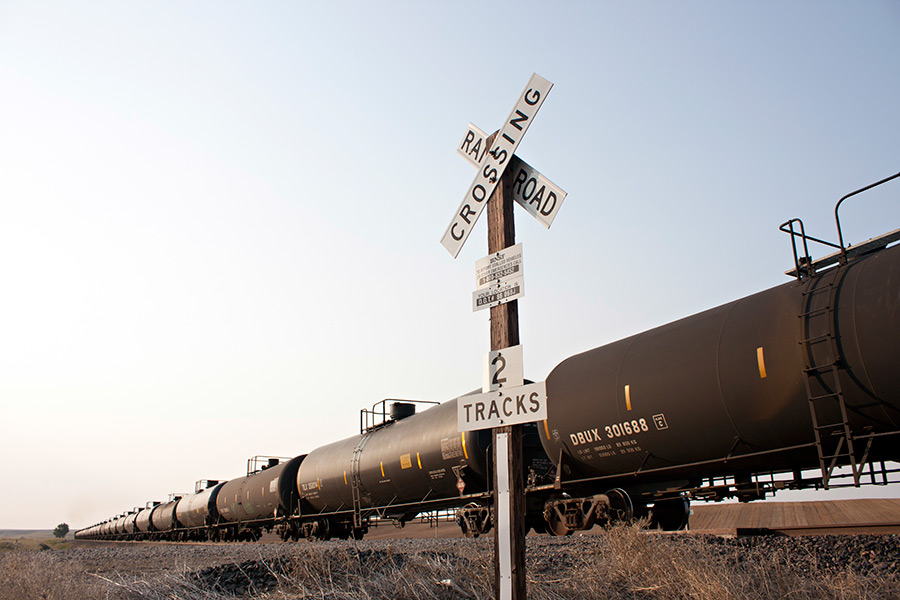In an effort to prevent explosive oil train wrecks, United States and Canadian regulators are requiring railroads to use tougher tank cars and install enhanced braking systems.
On May 1, transportation officials from both sides of the border gathered in Washington, D.C. to announce a sweeping set of regulations for oil trains across the continent. The new rules follow a series of explosive accidents and come nearly two years after an oil train derailed and exploded in Quebec, killing 47 people and leveling 30 buildings.
BNSF Railway runs 11 to 16 oil trains a week through Northwest Montana along the boundary of Glacier National Park and along Whitefish Lake, according to information released by the state of Montana.
“These new interdependent regulations will improve safety,” said U.S. Transportation Secretary Anthony Foxx at a press conference with his Canadian counterpart, Minister of Transport Lisa Raitt. “These rules will make the transporting of oil-by-rail safer than it is today.”
The number of trains moving crude oil in North America has rapidly increased in recent years due to the Bakken oil boom in North Dakota. In 2008, Class 1 railroads, which include the largest rail companies in America, moved just 9,500 carloads of crude oil. Five years later, they moved more than 400,000 cars of crude.
Included in the rules is a requirement that older tank cars must be retrofitted or phased out of use within the next three to five years. All new tank cars will have to be built to DOT-117 specifications and have a thicker shell, a shield on each end to prevent it from being punctured by another car and thermal protection systems that will help contain a fire.
Oil trains will also have to be outfitted with “electronically controlled pneumatic” brake systems. The enhanced systems would help stop a train faster and keep the cars from violently running into each other in a derailment.
Other new rules require railroads to use routing analysis to determine where oil trains can be run safely and to reduce speeds. The DOT rulemaking requires all oil trains, otherwise known as “high-hazard flammable unit trains,” to move no faster than 50 miles per hour in general and 40 miles per hour in urban areas. Also, after 2021, trains that are not outfitted with the enhanced brake system will not be able to run faster than 30 miles per hour.
While federal officials have issued various emergency orders in recent months, the rules and regulations released Friday are the most extensive to date and are the result of nearly two years of work by regulators on both sides of the border.
The railroads themselves have also made efforts to move oil trains safer, and in March, BNSF Railway implemented its own rules for oil trains. Among them is a 35 mile-per-hour speed limit for all oil trains running through large municipal areas with populations over 100,000 people.
The railroad has also increased the number of track inspections along “critical waterways,” including the Flathead and Kootenai rivers and Whitefish Lake.
Earlier this year, BNSF also began to encourage its shippers to stop using the older tank cars, known as DOT-111 and CPC-1232 cars, within three years. Both types of cars have been involved in explosive wrecks in recent months, and in January, BNSF began to charge oil shippers $1,000 every time they used an older tank car.
In March, the American Fuel & Petrochemical Manufactures filed a lawsuit against the railroad alleging that new surcharge was unfair and illegal. The railroad has said the surcharge will encourage shippers to improve tank car safety. Most tank cars are owned by third-party leasing companies and not the railroads themselves.
In a statement to the Beacon, BNSF officials lauded regulators for putting forward new tank car standards. However, the railroad also noted that it is important to make sure that new regulations don’t reduce capacity because that could have a negative impact on the economy.
“BNSF has advocated for a safer tank car in the movement of crude oil and finally setting a new federal standard with get the next generation tank car into service and substantially reduce the risk of a release in the event of an incident,” the railroad said in a statement.
While the railroad industry and its largest lobbying group, the Association of American Railroads, have long supported tougher tank car standards, they have been adamantly opposed to enhanced braking systems, stating that there is no proof those systems would prevent derailments. Not long after the May 1 press conference, AAR president and CEO Edward R. Hamberger issued a statement applauding some of the new rules while criticizing others.
“The DOT’s study is flawed and the (electronically controlled pneumatic) brakes do not significantly improve safety and are unreliable,” Hamberger said. “No justified safety case for EPC brakes has ever been made.”
During the press conference, Canadian Minister of Transportation Raitt said she understood that these new regulations would be expensive for the rail industry. But Raitt noted that in the long run the safety improvements would be less expensive than having to respond to large derailments.
Since 2013, there have been at least 10 large oil train derailments in North America, including four in a three-week period this winter. The high-profile accidents have brought public scrutiny to the practice, including in the Flathead Valley, where concerns have been raised about possible incidents impacting Glacier Park and the Flathead River Basin.
Officials said that while accidents like the one in Lac-Mègantic, Quebec were disastrous, they have led to stronger regulations that will safeguard the public.
“We can never undo the harm that happened at Lac-Mègantic or the site of any other rail accident,” Raitt said. “But we can and must learn from these incidents.”
